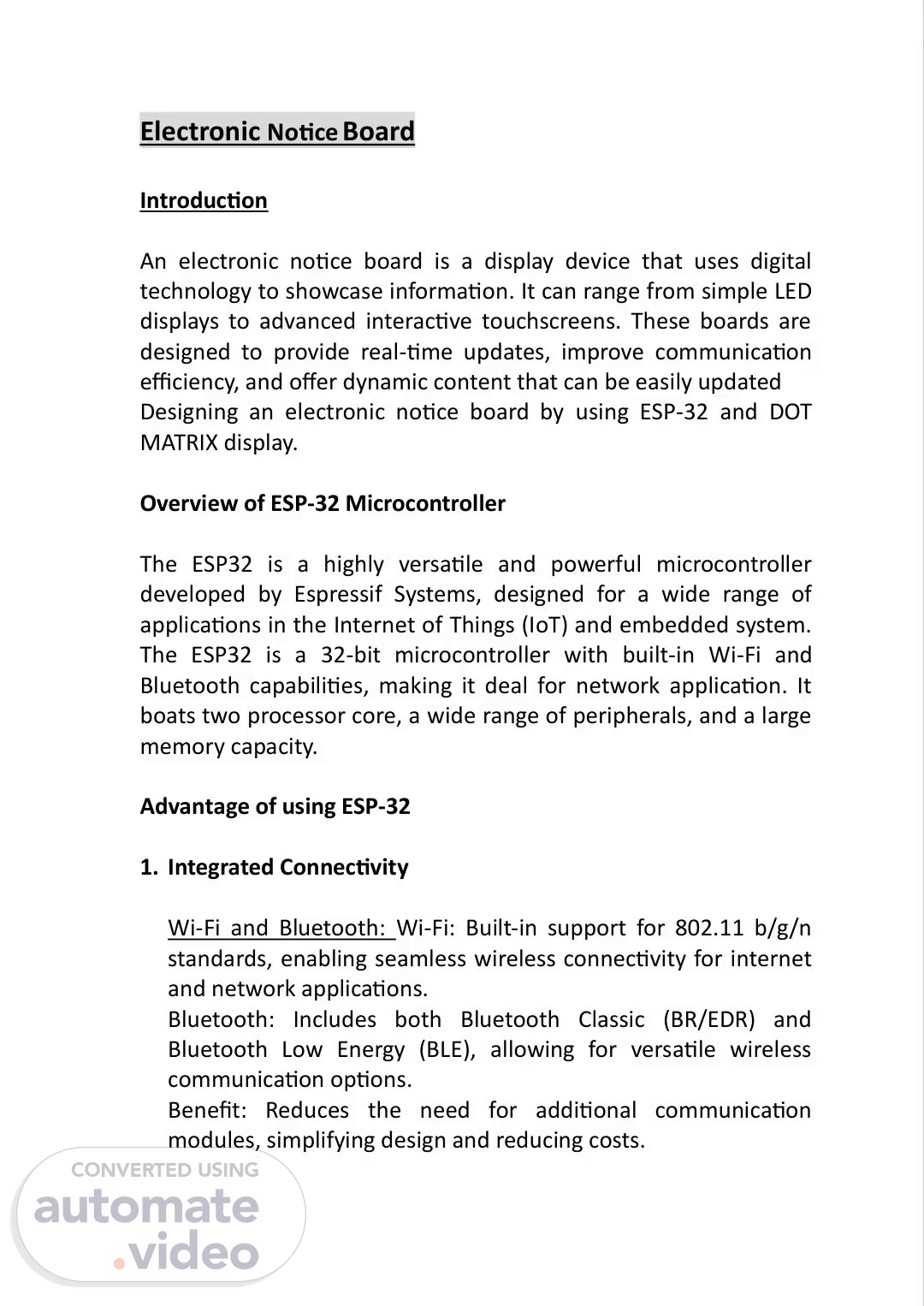Scene 1 (0s)
[Virtual Presenter] Electronic Notice Board Introduction An electronic notice board is a display device that uses digital technology to showcase information. It can range from simple L-E-D displays to advanced interactive touchscreens. These boards are designed to provide real-time updates, improve communication efficiency, and offer dynamic content that can be easily updated Designing an electronic notice board by using ESP-32 and D-O-T matrix display. Overview of ESP-32 Microcontroller The E-S-P-3-2 is a highly versatile and powerful microcontroller developed by Espressif Systems, designed for a wide range of applications in the Internet of Things (IoT) and embedded system. The E-S-P-3-2 is a 32-bit microcontroller with built-in Wi-Fi and Bluetooth capabilities, making it deal for network application. It boats two processor core, a wide range of peripherals, and a large memory capacity. Advantage of using ESP-32 1. Integrated Connectivity Wi-Fi and Bluetooth: Wi-Fi: Built-in support for 802.11 b/g/n standards, enabling seamless wireless connectivity for internet and network applications. Bluetooth: Includes both Bluetooth Classic (BR/EDR) and Bluetooth Low Energy (B-L-E--), allowing for versatile wireless communication options. Benefit: Reduces the need for additional communication modules, simplifying design and reducing costs..
Scene 2 (1m 39s)
[Audio] 2. Power Efficiency Power Management: Power Modes: Includes active, sleep, and deep sleep modes to optimize energy consume Voltage Range: Operates from 22 volts to 3.6 volts. Benefit: Enables energy-efficient designs, making the ESP32 suitable for battery-operated and low-power applications. 3. High Memory Capacity Memory Options: RAM: Up to 520 kilobytes of internal SRAM. Flash Memory: Supports external S-P-I flash up to 16 megabytes. Benefit: Sufficient memory for handling a wide range of applications, with the option to expand storage as needed. 4.Powerful Processing Capabilities Dual-Core Processor: Cores: Dual 32-bit Xtensa L-X-6 microprocessors. Clock Speed: Up to 240 MHz per core. Benefit: Provides substantial processing power and efficiency, allowing for complex tasks and multitasking in applications. 5.Cost-Effective Affordability: Cost: Generally low-cost relative to the features and capabilities provided. Benefit: Offers a high value-to-cost ratio, making it an attractive option for both-hobbyists and commercial products. A literature review Wireless Communication: E-S-P-3-2 module provides the facility of Wi-Fi and Bluetooth with which the messages can be sent through mobile phones to the display. Dot Matrix Displays: The systems are equipped with L-E-D dot matrix for better visibility and can come in any dimension to improve the distance viewing of messages..
Scene 3 (3m 20s)
[Audio] User-Friendly Interfaces: M-I-T App Inventor and similar tools enable management of messages and their display so as to enhance arrangement of messages in public. Environmental Benefits: Moving away from paper to digital notices minimizes waste as well as supports the reduction of paper used in society. They show applies the possibilities of developing technologies and unexpected ways of their application in nano-devices. research A-N-D methodology To ensure the success of our project, thorough research is essential. We discuss the methodologies used in designing and developing Electronic Notice board. This includes requirements analysis, design and prototyping, software development, integration and testing, and deployment and maintenance. By following a systematic approach, we can create a well-functioning Electronic Notice board. It involves a series of steps and processes aimed at achieving the desired functionality and performance of the board. 1. Agile Development: Iterative and incremental approach, emphasising flexibility and rapid delivery. 2. Waterfall Methodology: Linear and sequential approach. Muchemphasised proper planning and documentation are done. 3. Scrum Framework:Approach using collaboration in iterative manner conducted through sprints and stand-ups every day. 4. _Kanban Methodology:It is a visual approach with much flexibility around continuous improvement and delivery. 5. Rapid Prototyping: Iterative and experimental approach that emphasises fast testing and refinement. 6. User-entered Design (U-C-D--): Human-entered approach; it places a great emphasis on user needs and experiences..
Scene 4 (4m 59s)
[Audio] 7. Test-Driven Development-TDD: A development approach that is highly focused on automated testing and validation. 8. Extreme Programming-XP: An iterative-incremental software development method that focuses greatly on technical excellence and teamwork. 9. Lean Software Development: This efficient, waste-reducing approach is highly engaged with continuous improvement. 10. Hybrid Methodology:The combination of elements from multiple methodologies that can provide a better fit for the unique demands of a project. These methodologies can be applied to different aspects of the development of the Electronics Notice Board, such as but not limited to: a) Hardware design and development b) Software development and integration c) User interface and user experience design d) Testing and quality assurance e) Deployment and maintenance Thus, the selection of an appropriate methodology or combination of methodologies ensures the successful and effective implementation of the Electronics Notice Board. Simulation software The electronic notice boards with E-S-P-3-2 and dot matrix displays often provide an enabling environment through the use of different components and libraries. 1. Communicational functionality with max7219: In most cases, the max7319 module serves the purpose of driving L-E-D dot matrix displays connected to ESP32. Thus, an accumulated message in the dot matrix can be built using the libraries . 2. Mobile Applications: The applications created from M-I-T App Inventor also allow sending messages to E-S-P-3-2 over Wi-Fi where the messages are then appropriated on the dot matrix..
Scene 5 (6m 44s)
[Audio] 3. Web Interface: Other works implemented a web based system through which the users could send messages which the E-S-P-3-2 would display on the matrix. Collectively, these features aim at improving both the usefulness and the interaction experience of electronic notice boards with end users. Conclusion In this project, an ESP32-C6 WiFi Module can be interfaced with an 8-in-1 max7219 Dot Matrix L-E-D Display. ESP32-C6 connects to WiFi network and creates web page. It is possible to view the webpage through the local IP address of the ESP32-C6. Any message can be sent and displayed using the Dot Matrix L-E-D Display with the help of the Web Dashboard..
